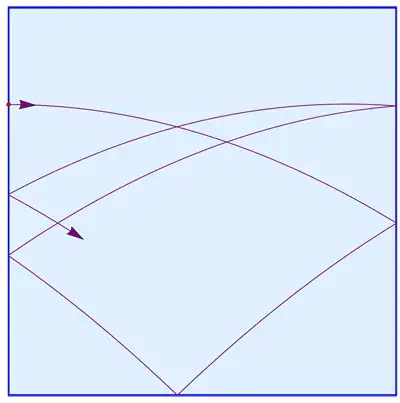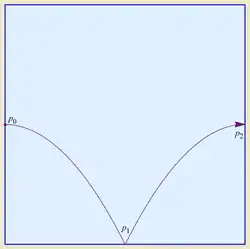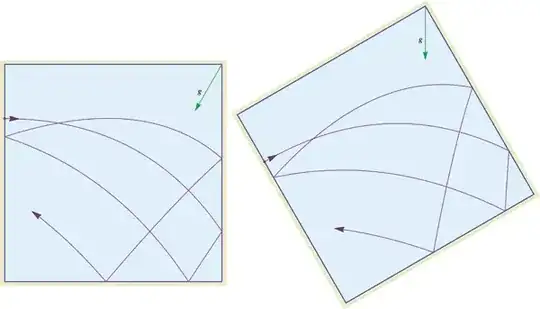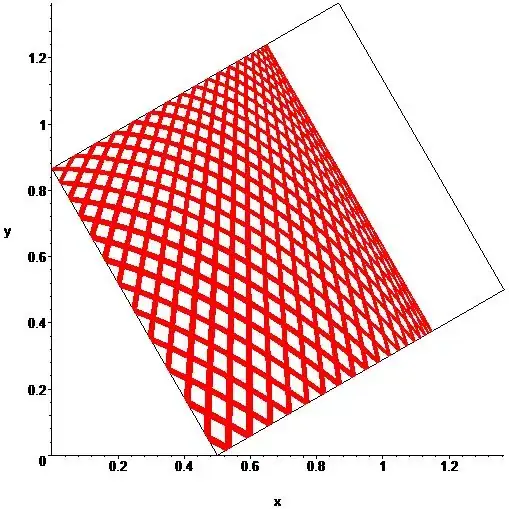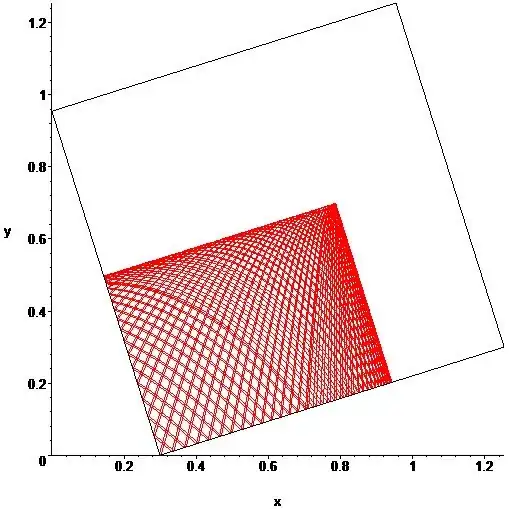As Willie Wong pointed out early on in the comments to the original problem, conservation of energy applies to the billiard ball in the tilted (or untilted) square, and this in itself can prevent the ball from ever passing through certain points. In her answer analyzing Robert Israel's picture, Katie Mann expands on this. Let me try to flesh things out further.
It's worth viewing the billiard trajectory as taking place in the four copies of the unit square comprising the lefthand half of Katie's picture, with the four different directions for gravity. Let's think of this as the "Unit Square" $[-1,1]\times[-1,1]$ (as distinct from the "unit square" $[0,1]\times[0,1]$), with gravity vectors $(\pm\cos\theta,\pm\sin\theta)$, where $\theta = \pi/6$ and the signs are chosen for the quadrants so that gravity points generally toward the origin (i.e., toward the $x$ and $y$ axes). In this setting we can use toroidal boundary conditions instead of reflections to follow trajectories.
In his clarification of Katie's answer, Robert notes that the "$y$ component of energy" in the Unit Square is conserved. This holds for the "$x$ component" as well. This means that the two components of motion are completely independent! And this means that each component is simply described, as in my answer to the original problem (for the untilted square), by a repeating sequence of quadratic functions of time, each with its own period. Whether the overall billiard trajectory is periodic depends only on whether the ratio of these two periods is rational.
Robert's trajectory can be viewed as starting at $(-1,0)$ in the Unit Square with initial velocity $(\sin\theta,\cos\theta)$ subject to gravity vector $(\cos\theta,-\sin\theta)$. This means the $y$ component of the motion is described (initially) by
$$y(t)=t\cos\theta - (1/2)t^2\sin\theta$$
which maxes out when $t=\cos\theta/\sin\theta = \sqrt3$ (with $y(\sqrt3)=(6-3\sqrt3)/4 < 1$, so that, as Katie observed, the $y$ component of the trajectory never hits its "ceiling"). Thus the $y$ component in the Unit Square has period $4\sqrt3$.
The $x$ component, on the other hand, starts out from its "ceiling" heading toward its "floor" with equation
$$x(t) = -1 + t\sin\theta + (1/2)t^2\cos\theta$$
so that it completes half its cycle when
$$t = {\sqrt{\sin^2\theta + 2\cos\theta}-\sin\theta \over \cos\theta} = {\sqrt{1+4\sqrt3}-1 \over \sqrt3}$$
The ratio of the two periods, therefore, is $(\sqrt{1+4\sqrt3}-1)/2$, a decidedly irrational number. (Indeed, the ungainliness of this result makes me worry I've made a mistake somewhere in the algebra. Someone should doublecheck my work in any event, and please correct me if I'm wrong.) The irrationality of the ratio implies that Robert's trajectory is non-periodic.
It's worth considering what happens if one simply lets a billiard ball drop from the topmost point of the tilted square. This is equivalent to starting with zero velocity from $(-1,1)$ in the Unit Square, and in this case each component goes from its respective "ceiling" to "floor" and back, with equations
$$x(t) = -1 + (1/2)t^2\cos\theta$$
and
$$y(t) = 1 - (1/2)t^2\sin\theta$$
which makes the ratio of the two components' periods equal to $\tan\theta$. For $\theta = \pi/6$ this is irrational, implying this trajectory is also non-periodic, but for other values of $\theta$, of course, the ratio can be rational. In particular, if you take the square on the hypotenuse of a right rational triangle (with the other two sides horizontal and vertical), and drop a billiard ball from its uppermost corner, the resulting trajectory will be periodic.
I hope I haven't gotten too much wrong here.
Correction (added August 3): In addition to the minor error Joseph O'Rourke pointed out in the comments, I was utterly wrong in what I said about right rational triangles. That's because the ratio of the periods for a ball dropped from the upper corner of a tilted square is $\sqrt{\tan
\theta}$, not $\tan\theta$. There are certainly $\theta$'s for which $\sqrt{\tan\theta}$ is rational, but none of them come from right rational triangles, as that would violate Fermat's proscription on solutions to the equation $a^4 + b^4 = c^2$.
